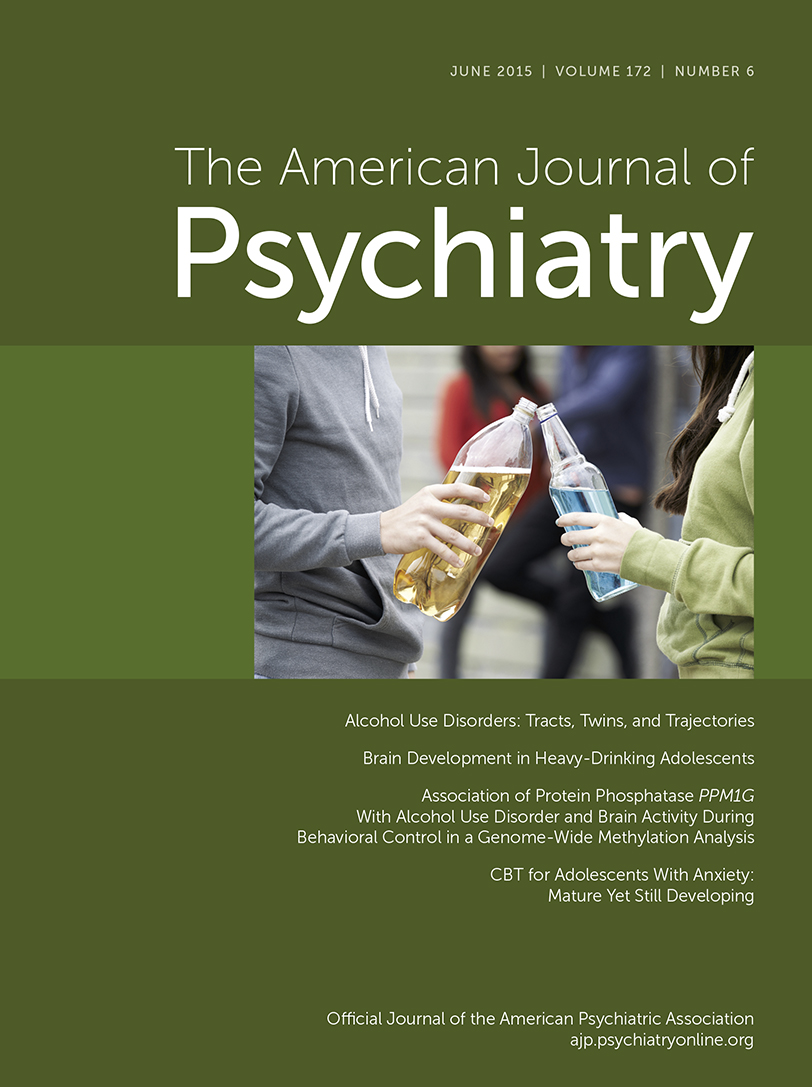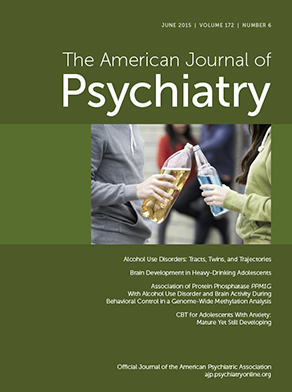In this issue, two studies that use disparate methodologies have the potential to provide powerful leads into the etiology and diagnosis of alcohol use disorders. In a study by Squeglia et al. (
1), heavy-drinking adolescents showed an accelerated gray matter reduction in the cortical lateral frontal and temporal lobes and attenuated white matter growth of the corpus callosum and pons relative to nondrinking control subjects. In a study by Ruggeri et al. (
2), alcohol use disorders were associated with hypermethylation in the 3′-protein-phosphatase-1G (
PPM1G) gene locus; more specifically,
PPM1G hypermethylation was associated with the escalation of alcohol use, increased impulsiveness, and increased activity in the right subthalamic nucleus. How are these two observations—one on neurocircuitry imaging changes in adolescents and one on protein phosphatase methylation in adolescents—related?
The adolescent brain undergoes widespread changes in form and function, both within individual regions and in the connections between them. Studies have shown that a reduction of cortical gray matter begins in preadolescence and continues into the mid-20s, possibly reflecting a normal pruning process (
3,
4). Equally compelling are data showing that white matter volume increases over the course of adolescence, presumably reflecting connectivity changes, including axonal extension and myelination (
4). Mounting evidence suggests that the complex changes underlying neurodevelopment render the adolescent brain particularly vulnerable to the deleterious effects of alcohol. Heavy alcohol use during adolescence is associated with a range of neurobehavioral sequelae, including impairments in visuospatial processing, attention, and memory (
5,
6) and an increased risk for future alcohol use disorders.
Alcohol use disorder is a chronically relapsing disorder characterized by the compulsive use of alcohol, loss of control over intake, and development of a negative emotional state when alcohol is unavailable. Our knowledge of alcohol use disorder has advanced tremendously through the explosion in knowledge of the neurocircuitry of addiction, both general and alcohol specific. One heuristic framework for the neurocircuitry of addiction is to divide addiction disorders into three stages: binge/intoxication, withdrawal/negative affect, and preoccupation/anticipation (“craving”). These stages link the functional components of addiction to changes in neurocircuitry that are relevant to these new developments that identify key predictors of future pathology. The neurobiological basis of the binge/intoxication stage involves the facilitation of incentive salience and is mediated largely by neurocircuitry within the basal ganglia. The basal ganglia are associated with numerous key functions, including voluntary motor control, procedural learning related to routine behaviors or habits, and action selection. The release of dopamine and opioid peptides in the ventral striatum (nucleus accumbens) has long been associated with the reinforcing actions of alcohol. For example, human imaging studies have shown that intoxicating doses of alcohol release dopamine and opioid peptides into the ventral striatum (
7,
8). As a result, alcohol conveys motivational properties to previously neutral stimuli, known as incentive salience. This activation of the ventral striatum leads to the recruitment of basal ganglia-globus pallidus-thalamic-cortical loops that engage dorsal striatum habit formation and strengthening, hypothesized to be the beginning of compulsive-like responding for drugs.
Subsequently and perhaps in parallel, two processes are hypothesized to form the neurobiological basis of the withdrawal/negative affect stage: loss of function in the reward systems (within-system neuroadaptation) in the ventral striatum and recruitment of the brain stress systems (between-system neuroadaptation) in the extended amygdala, including the bed nucleus of the stria terminalis, the central nucleus of the amygdala, the sublenticular substantia innominata, and a transition zone in the medial part of the nucleus accumbens (e.g., the shell) (
9). As dependence (defined as the manifestation of motivational withdrawal symptoms) develops, brain stress systems, such as corticotropin-releasing factor and dynorphin, are recruited, producing aversive or stress-like states (
10,
11). The combination of decreases in reward neurotransmitter function and recruitment of brain stress systems provides a powerful motivation for reengaging in drug taking and drug seeking.
The preoccupation/anticipation (“craving”) stage in alcoholism involves dysregulation of executive control via prefrontal cortex circuits. In individuals with alcoholism, there are disruptions of decision making, impairments in the maintenance of spatial information, and impairments in behavioral inhibition, all of which can drive craving. One can conceptualize two opposing systems for such executive function: a go system and a stop system. The go system consists of the anterior cingulate cortex and dorsolateral prefrontal cortex and engages habits via the basal ganglia. The stop system consists of the ventrolateral prefrontal cortex and orbitofrontal cortex and inhibits the basal ganglia incentive salience system and extended amygdala stress system. Thus, deficits in the prefrontal cortical control of basal ganglia and extended amygdala function may represent a key mechanism to explain individual differences in the predisposition or vulnerability to alcohol use disorders, helping to perpetuate excessive alcohol intake, compulsive behavior, and relapse.
Based on this neurocircuitry background, the observations in Squeglia et al. (
1) and Ruggeri et al. (
2) become intimately related. In the Ruggeri et al. study, hypermethylation was identified in 18 monozygotic twin pairs nonconcordant for alcohol use disorder using a genome-wide methylation analysis and then associated with the escalation of alcohol use in a sample of 499 adolescents from the IMAGEN study. Using microarray analysis, the authors identified 77 regions that exhibited alcohol use disorder-associated differential methylation, and 68% of these were hypermethylated in the affected twins. The most significant hypermethylation associated with alcohol use disorder was found for
PPM1G. A more detailed analysis and validation was conducted in the sample of 499 adolescents from the IMAGEN study, and an association with the escalation of drinking between ages 14 and 16 was observed. Moreover, the escalation of drinking was associated with impulsiveness, which in turn was also associated with
PPM1G hypermethylation. Increased
PPM1G methylation is accompanied by decreased mRNA levels. What is even more remarkable is the observation that protein phosphatase hypermethylation was linked to brain activation in the subthalamic nucleus, where the authors found a positive association between
PPM1G methylation and blood-oxygen-level-dependent response in the right subthalamic nucleus. The subthalamic nucleus is a key part of a frontal basal ganglia thalamic pathway that includes the prefrontal cortex (
12,
13). The prefrontal cortex mediates the inhibition of manual movements via activation of the subthalamic nucleus (part of the prefrontal cortex control of impulsivity). Indeed, in rodent studies, lesions of the subthalamic nucleus have been reported to block impulsivity and the development of compulsive drug-seeking behavior (
14–
16).
In the Squeglia et al. study (
1), adolescents who had engaged in episodes of heavy drinking presented faster declining volumes in some neocortical gray matter regions and smaller increases in regional white matter volumes relative to nondrinking adolescents. Two particularly important and unique aspects of this study were the longitudinal assessments and the large sample size (59 nondrinking adolescent control subjects and 75 adolescent heavy drinkers who were followed from ages 13 to 24, with at least two scans for each subject). Longitudinal assessments provide insights into the effects of alcohol on normal adolescent neurodevelopmental trajectories. Given the normal beneficial processes of neuronal pruning, one could argue that one may have been more likely to observe less pruning in the heavy drinkers, but this was not the case. Indeed, the authors suggested that the pattern of decreased gray matter may reflect “accelerated but nonbeneficial pruning” or “premature cortical gray matter decline similar to senescent volume declines seen in adult alcoholics or even ‘normal’ aging.” Another key element of the Squeglia et al. study is that male and female heavy-drinking adolescents sustained similar alterations in developmental trajectories of cortical and white matter brain volume growth.
One could superficially argue that an imaging study in heavy-drinking adolescents and a twin study that isolates epigenetic hypermethylation in the discordant twin have little, if anything, that links them, other than heavy drinking. However, the imaging changes were most prominent in the lateral frontal cortex, and the epigenetic changes were localized to the subthalamic nucleus: Not only are these two structures linked neuroanatomically (
12,
13) and functionally (
17,
18; see above), but they are critically linked to stages of the addiction cycle, specifically the preoccupation/anticipation stage and the binge/intoxication stage.
A poignant point of convergence of the findings in these two studies is that drug addiction has also been associated with general hypofunction of the ventral prefrontal cortex (
19,
20). Considering the key role of the ventral prefrontal cortex in processing the consequences of future actions (
21), inhibition of actions (
22), and control of emotions (
21), investigating the epigenetic mechanisms in the ventral prefrontal cortex (processing a stop signal, as noted above) in alcohol addiction would be important.
In summary, the findings from Squeglia et al. and Ruggeri et al. converge to reveal that epigenetic changes in subcortical structures, the subthalamic nucleus in particular, precede the escalation of alcohol use in adolescents, and heavy drinking during adolescence alters normal neurodevelopmental pathways, resulting in faster declines in the volumes of some neocortical gray matter regions and smaller increases in regional white matter volumes relative to nondrinking adolescents. It is possible that such epigenetic changes, by increasing impulsivity, predispose adolescents to engage in excessive drinking and that the alterations in brain circuitry that follow excessive drinking, by disrupting executive function, make it harder to stop. If such changes are not reversible, then they could help explain the increased risk of enduring alcohol use disorders in adulthood following excessive drinking during adolescence.
Acknowledgments
The author thanks Adolph Pfefferbaum, Aaron White, Antonio Noronha, and Patricia Powell for their comments on the manuscript and Michael Arends for assistance with manuscript preparation.

